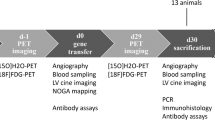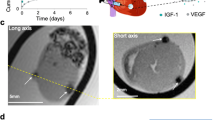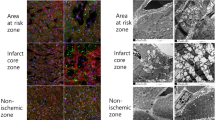Abstract
We investigated the long-term effects of human hepatocyte growth factor (HGF) gene therapy in a rat myocardial infarct model. Treatment adenovirus coexpressing the HGF therapeutic gene and the human sodium/iodide symporter (NIS) reporter gene or control adenovirus expressing the NIS gene alone were injected directly into the infarct border zone immediately after permanent coronary ligation in rats (n=6 each). A uniform disease state was confirmed in the acute phase in terms of impaired left ventricular (LV) function by cine magnetic resonance imaging (MRI), large infarct extent by 99mTc-tetrofosmin single-photon emission computed tomography (SPECT) and successful gene transfer and expression by 99mTcO4− SPECT. After a 10-week follow-up, repeated cine MRI demonstrated no significant difference in the LV ejection fraction between the time points or groups, but a significantly increased end-diastolic volume from the acute to the chronic phase without a significant difference between the groups. Capillary density was significantly higher in the treatment group, whereas arteriole density remained unchanged. Two-photon excitation fluorescence microscopy revealed extremely thin capillaries (2–5 μm), and their irregular networks increased in the infarct border zone of the treated myocardium. Our results indicated that single HGF gene therapy alone induced an immature and irregular microvasculature.
This is a preview of subscription content, access via your institution
Access options
Subscribe to this journal
Receive 12 print issues and online access
$259.00 per year
only $21.58 per issue
Buy this article
- Purchase on Springer Link
- Instant access to full article PDF
Prices may be subject to local taxes which are calculated during checkout





Similar content being viewed by others
References
Isner JM . Myocardial gene therapy. Nature 2002; 415: 234–239.
Inubushi M, Tamaki N . Radionuclide reporter gene imaging for cardiac gene therapy. Eur J Nucl Med Mol Imaging 2007; 34: S27–S33.
Morishita R, Aoki M, Hashiya N, Yamasaki K, Kurinami H, Shimizu S et al. Therapeutic angiogenesis using hepatocyte growth factor (HGF). Curr Gene Ther 2004; 4: 199–206.
Jin H, Wyss JM, Yang R, Schwall R . The therapeutic potential of hepatocyte growth factor for myocardial infarction and heart failure. Curr Pharm Des 2004; 10: 2525–2533.
Funatsu T, Sawa Y, Ohtake S, Takahashi T, Matsumiya G, Matsuura N et al. Therapeutic angiogenesis in the ischemic canine heart induced by myocardial injection of naked complementary DNA plasmid encoding hepatocyte growth factor. J Thorac Cardiovasc Surg 2002; 124: 1099–1105.
Ahmet I, Sawa Y, Yamaguchi T, Matsuda H . Gene transfer of hepatocyte growth factor improves angiogenesis and function of chronic ischemic myocardium in canine heart. Ann Thorac Surg 2003; 75: 1283–1287.
Li Y, Takemura G, Kosai K, Yuge K, Nagano S, Esaki M et al. Postinfarction treatment with an adenoviral vector expressing hepatocyte growth factor relieves chronic left ventricular remodeling and dysfunction in mice. Circulation 2003; 107: 2499–2506.
Jayasankar V, Woo YJ, Bish LT, Pirolli TJ, Chatterjee S, Berry MF et al. Gene transfer of hepatocyte growth factor attenuates postinfarction heart failure. Circulation 2003; 108: II230–II236.
Kondo I, Ohmori K, Oshita A, Takeuchi H, Fuke S, Shinomiya K et al. Treatment of acute myocardial infarction by hepatocyte growth factor gene transfer: the first demonstration of myocardial transfer of a “functional” gene using ultrasonic microbubble destruction. J Am Coll Cardiol 2004; 44: 644–653.
Jayasankar V, Woo YJ, Pirolli TJ, Bish LT, Berry MF, Burdick J et al. Induction of angiogenesis and inhibition of apoptosis by hepatocyte growth factor effectively treats postischemic heart failure. J Card Surg 2005; 20: 93–101.
Azuma J, Taniyama Y, Takeya Y, Iekushi K, Aoki M, Dosaka N et al. Angiogenic and antifibrotic actions of hepatocyte growth factor improve cardiac dysfunction in porcine ischemic cardiomyopathy. Gene Therapy 2006; 13: 1206–1213.
Yang Z, Wang W, Ma D, Zhang Y, Wang L, Zhang Y et al. Recruitment of stem cells by hepatocyte growth factor via intracoronary gene transfection in the postinfarction heart failure. Sci China C Life Sci 2007; 50: 748–752.
Chen XH, Minatoguchi S, Kosai K, Yuge K, Takahashi T, Arai M et al. In vivo hepatocyte growth factor gene transfer reduces myocardial ischemia-reperfusion injury through its multiple actions. J Card Fail 2007; 13: 874–883.
Li X, Wang Z, Ran H, Li X, Yuan Q, Zheng Y et al. Experimental research on therapeutic angiogenesis induced by hepatocyte growth factor directed by ultrasound-targeted microbubble destruction in rats. J Ultrasound Med 2008; 27: 453–460.
Yuan B, Zhang Y, Zhao Z, Wu D, Yuan L, Wu B et al. Treatment of chronical myocardial ischemia by adenovirus-mediated hepatocyte growth factor gene transfer in minipigs. Sci China C Life Sci 2008; 51: 537–543.
Cho KR, Choi JS, Hahn W, Kim DS, Park JS, Lee DS et al. Therapeutic angiogenesis using naked DNA expressing two isoforms of the hepatocyte growth factor in a porcine acute myocardial infarction model. Eur J Cardiothorac Surg 2008; 34: 857–863.
Yang ZJ, Chen B, Sheng Z, Zhang DG, Jia EZ, Wang W et al. Improvement of heart function in postinfarct heart failure swine models after hepatocyte growth factor gene transfer: comparison of low-, medium- and high-dose groups. Mol Biol Rep 2010; 37: 2075–2081.
Kakinuma H, Bergert ER, Spitzweg C, Cheville JC, Lieber MM, Morris JC . Probasin promoter (ARR(2)PB)-driven, prostate-specific expression of the human sodium iodide symporter (h-NIS) for targeted radioiodine therapy of prostate cancer. Cancer Res 2003; 63: 7840–7844.
Inubushi M, Wu JC, Gambhir SS, Sundaresan G, Satyamurthy N, Namavari M et al. Positron-emission tomography reporter gene expression imaging in rat myocardium. Circulation 2003; 107: 326–332.
Brown RE . The pattern of the microcirculatory bed in the ventricular myocardium of domestic mammals. Am J Anat 1965; 116: 355–374.
Waller C, Hiller KH, Kahler E, Hu K, Nahrendorf M, Voll S et al. Serial magnetic resonance imaging of microvascular remodeling in the infarcted rat heart. Circulation 2001; 103: 1564–1569.
Rissanen TT, Ylä-Herttuala S . Current status of cardiovascular gene therapy. Mol Ther 2007; 15: 1233–1247.
Gounis MJ, Spiga MG, Graham RM, Wilson A, Haliko S, Lieber BB et al. Angiogenesis is confined to the transient period of VEGF expression that follows adenoviral gene delivery to ischemic muscle. Gene Therapy 2005; 12: 762–771.
Olea FD, Vera Janavel G, Cuniberti L, Yannarelli G, Cabeza Meckert P, Cors J et al. Repeated, but not single, VEGF gene transfer affords protection against ischemic muscle lesions in rabbits with hindlimb ischemia. Gene Therapy 2009; 16: 716–723.
Jin ZH, Furukawa T, Galibert M, Boturyn D, Coll JL, Fukumura T et al. Noninvasive visualization and quantification of tumor αVβ3 integrin expression using a novel positron emission tomography probe, 64Cu-cyclam-RAFT-c(-RGDfK-)4. Nucl Med Biol 2011; 38: 529–540.
Miyagawa S, Sawa Y, Taketani S, Kawaguchi N, Nakamura T, Matsuura N et al. Myocardial regeneration therapy for heart failure: hepatocyte growth factor enhances the effect of cellular cardiomyoplasty. Circulation 2002; 105: 2556–2561.
Rosenfeld MA, Yoshimura K, Trapnell BC, Yoneyama K, Rosenthal ER, Dalemans W et al. In vivo transfer of the human cystic fibrosis transmembrane conductance regulator gene to the airway epithelium. Cell 1992; 68: 143–155.
Jaffe HA, Danel C, Longenecker G, Metzger M, Setoguchi Y, Rosenfeld MA et al. Adenovirus-mediated in vivo gene transfer and expression in normal rat liver. Nat Genet 1992; 1: 372–378.
Smanik PA, Liu Q, Furminger TL, Ryu K, Xing S, Mazzaferri EL et al. Cloning of the human sodium lodide symporter. Biochem Biophys Res Commun 1996; 226: 339–345.
Spitzweg C, Zhang S, Bergert ER, Castro MR, McIver B, Heufelder AE et al. Prostate-specific antigen (PSA) promoter-driven androgen-inducible expression of sodium iodide symporter in prostate cancer cell lines. Cancer Res 1999; 59: 2136–2141.
Lee WW, Moon DH, Park SY, Jin J, Kim SJ, Lee H . Imaging of adenovirus-mediated expression of human sodium iodide symporter gene by 99mTcO4 scintigraphy in mice. Nucl Med Biol 2004; 31: 31–40.
Heijman E, de Graaf WL, Niessen P, Nauerth A, van Eys G, de Graaf L et al. Comparison between prospective and retrospective triggering for mouse cardiac MRI. NMR Biomed 2007; 20: 439–447.
Masamoto K, Obata T, Kanno I . Intracortical microcirculatory change induced by anesthesia in rat somatosensory cortex. Adv Exp Med Biol 2010; 662: 57–61.
Masson P . Some histological methods: trichrome stainings and their preliminary technique. J Techn Meth 1929; 12: 75–90.
Acknowledgements
We thank Professor Masanori Hatakeyama of University of Tokyo and Professor Hideaki Higashi of Hokkaido University for technical guidance in molecular biology, and Ms Sayaka Shibata and Mr Shigeyoshi Saito of National Institute of Radiological Sciences for assisting MRI experiments. We also thank SII NanoTechnology Inc. for providing us the small-animal SPECT/CT system. This study was supported in part by Grants-in-Aid for Scientific Research (B) (general; MI nos. 18390326 and 22390239) from the Ministry of Education, Culture, Sports, Science and Technology (MEXT), Japanese Government.
Author information
Authors and Affiliations
Corresponding author
Ethics declarations
Competing interests
The authors declare no conflict of interest.
Rights and permissions
About this article
Cite this article
Jin, YN., Inubushi, M., Masamoto, K. et al. Long-term effects of hepatocyte growth factor gene therapy in rat myocardial infarct model. Gene Ther 19, 836–843 (2012). https://doi.org/10.1038/gt.2011.128
Received:
Revised:
Accepted:
Published:
Issue Date:
DOI: https://doi.org/10.1038/gt.2011.128
Keywords
This article is cited by
-
Intravital imaging with two-photon microscopy reveals cellular dynamics in the ischeamia-reperfused rat heart
Scientific Reports (2018)
-
Detailed assessment of gene activation levels by multiple hypoxia-responsive elements under various hypoxic conditions
Annals of Nuclear Medicine (2014)



